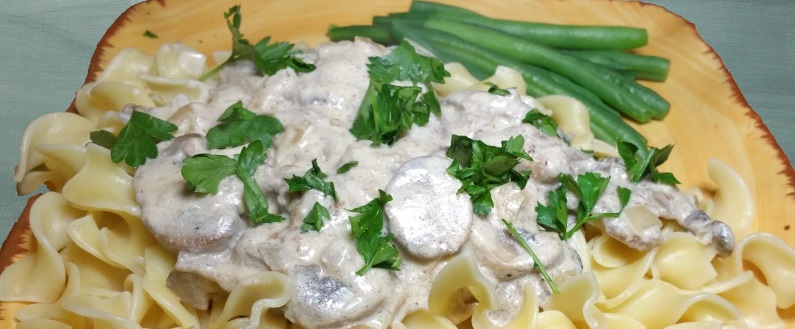
Russian beef stroganoff (or stroganov) is a hearty dish will insulate you from those terribly cold winter nights here in San Diego! It's a quintessential comfort food with just a few ingredients, so it's quick and easy to prepare. The name 'stroganoff' has uncertain origins. The name either comes from the family name Stroganoff, or from the Russian word stroganina, which means chipped or shaved. The dish was first mentioned in the 1871 Russian cookbook "A Gift to Young Housewives". It would be an understatement to say that wealthy Russians in the 1800s were fanatic Francophiles. Indeed, Russian elites of the time were more often than not educated in French schools, kept apartments in trendy Paris, spoke French between themselves and modeled their behavior on French customs. In 1891, a French Chef named Charles Briere won the St. Petersburg cooking contest with beef stroganoff. The dish took off in Russia, and just a few decades later, it also became popular in China, particularly in Shanghai. Stroganoff didn't become popular in the United States until after WWII, when there was a rise of interest in international cuisine, which was influenced by returning GIs as well as Chinese and Russian immigrants. Perhaps the most iconic version of the dish in the States is prepared by the Old Russian Tea Room in New York City.
The 1871 recipe calls for cubes of floured and sautéed beef with mustard, bullion, and a small amount of sour cream (smetana). Subsequent versions mostly dropped the mustard. They use slices of beef (not cubes), more sour cream and white wine, sautéed mushrooms, and onions. In Nordic countries, sausages are often substituted for the beef. The Old Russian Tea Room version retains the mustard but also includes all the newer ingredients as well. In the 1950s and 60s, many people chose to make the dish with cream of mushroom soup, which Paula Dean's recipe also calls for. If you follow our recipe, your taste buds will appreciate the minimally extra effort to get the dish right.
Traditionally in Russia, stroganoff is served over mashed potatoes but elsewhere it is commonly served over wide egg noodles. Some recipes suggest serving over rice. We prefer German egg noodles, which are astonishingly better than the egg noodles normally found in mainstream supermarkets. We use Bechtle German noodles which can be bought at World Market, online or at the European market on Regents Road in La Jolla. I think they are the only noodles of any kind that are buttery enough to be enjoyed all by themselves without any sauce whatsoever!
Ingredients:
- 1 1/2 pounds boneless sirloin steak (or similar cut)
- 1/4 cup all-purpose flour
- 2 teaspoons salt
- 1 teaspoon ground black pepper
- 1 tablespoon all-purpose flour
- 4 tablespoons butter
- 2 tablespoons olive oil
- 1 medium onion, sliced thinly
- 1 teaspoon Worcestershire sauce
- 1/2 cup dry white wine
- 1/2 pound mushrooms, sliced thinly
- 1 1/2 cups sour cream
- 3 tablespoons fresh parsley, chopped
Preparation:
- Cut beef into 1/2-inch-wide slices.
- Pound beef slices until they are 1/4-inch thick to tenderize them.
- Cook noodles according to package directions (or make mashed potatoes or rice) while you complete the following steps.
- Combine flour, salt and pepper. Coat the beef with the mixture.
- Brown beef in the butter and olive oil.
- Remove beef and set aside.
- Sauté mushrooms and onion in the pan.
- Return beef to pan.
- Add white wine and Worcestershire sauce to pan.
- Stir in 1 tablespoon of flour* and cook for an additional 1 minute.
- Add sour cream and stir until the mixture is very warm. Do not let it boil!
- Remove pan from heat as soon as the Stroganoff is warm.
- Serve over a bed of wide noodles, mashed potatoes or rice, and garnish with chopped parsley.
* Cook's note: the flour will help keep the sour cream from curdling when heated, but remember to stop heating the Stroganoff sauce before it ends up boiling.
Recipe and photo by T. Johnston-O'Neill








